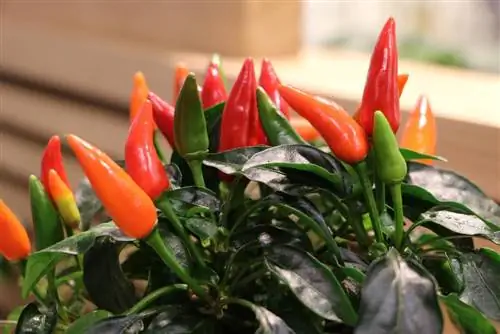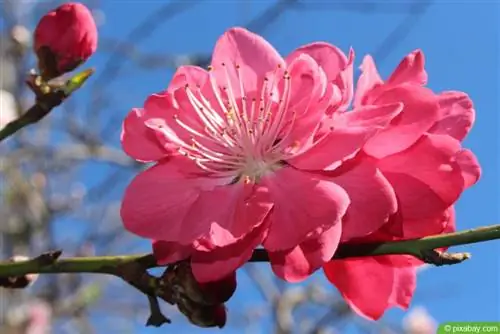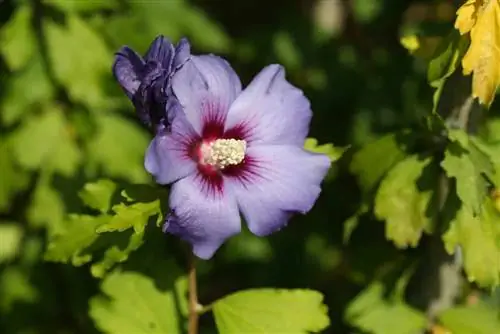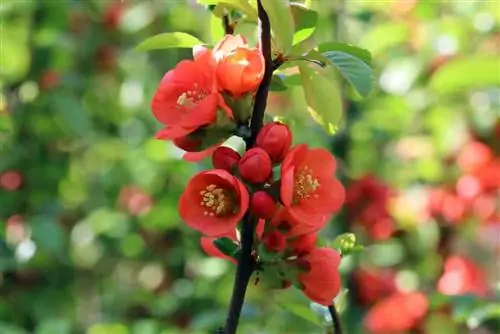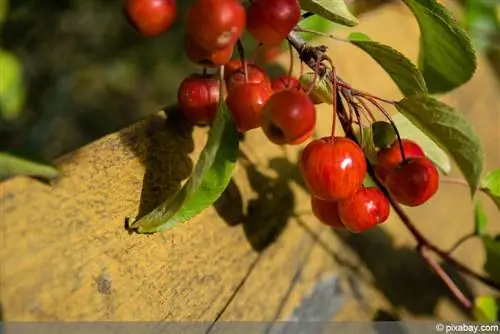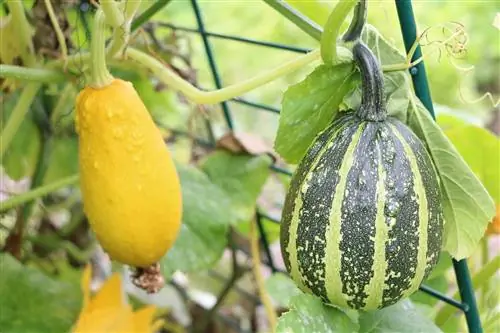- Author admin [email protected].
- Public 2023-12-17 03:39.
- Last modified 2025-06-01 06:48.
The sweet pepper (bot. Capsicum annuum), also known as Spanish pepper or ornamental pepper, is a small relative of the classic pepper and has been bred in this form specifically for use as a pot plant. The originally American plant is mostly offered in Germany in a variant that can easily be kept in your own home and its fruits can be harvested.
Is the nibble poisonous?
Many people ask themselves whether the Naschzipfel is a poisonous plant? This question can be clearly answered with a no. The fruit vegetable has a mild taste, is very digestible and, despite being called pepper, is not spicy. This is why the plant is so popular with children. The fruits can simply be picked, cut and consumed. Nevertheless, the question of possible toxicity is not unfounded, as the ornamental peppers often come from mass production and are treated with the following means:
- Growth inhibitors: keep the plant smaller than its original shape
- often chemical pesticides
You should definitely avoid eating such snacks, as they could really lead to general complaints. If you have decided to purchase a Naschzipfel, you should go to a breeder or a specialist retailer and purchase your specimens there. There you can ask whether the plant was home-grown or whether it comes from mass production. Of course, you shouldn't eat the following parts of the plant:
- leaves
- Stems
- Roots
- green spots on the fruits
Since ornamental peppers are a nightshade plant, these parts contain toxins, such as solanine, which can lead to vomiting, nausea and stomach problems. Otherwise, you don't have to worry and you can enjoy the fresh, ripe peppers without any worries.
Tip:
As an alternative to buying cultivated plants, you can also buy seeds. This is untreated and can be used just as well.
Location
The location for the ornamental peppers in the pot should have the following properties:
- Light requirements: sunny to partially shaded
- no direct midday sun
- airy
- Drafts should be avoided
- dry location
- rainproof
Make sure to give the sweet tooth enough sun, as this has a positive effect on the ripening of the fruit. At the same time, this increases the water requirement, which also intensifies the taste.
Substrate
The substrate for the ornamental pepper depends on the intended use of the potted plant:
- Ornamental plant: planting or potting soil
- Vegetable plant: herb or vegetable soil that has not been pre-fertilized
Since the Naschzipfel, as a purely ornamental plant, does not have to produce great fruits, using conventional potting soil is sufficient. This provides the plant with a sufficient basis for strong growth. For both variants, make sure you have high-quality soil that is permeable. A soil that is too dense would have a negative effect on root formation and the transport of moisture and nutrients. If necessary, work some quartz sand into the substrate to increase permeability.
Repotting
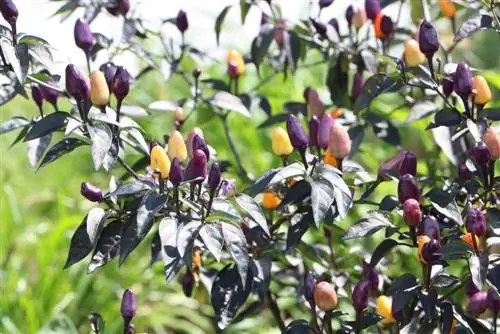
You should repot after you have bought a new specimen and the ornamental pepper is too large for its current container. Since the nightshade plant grows extremely quickly with good care, this step may be necessary for the next season. Repotting works as follows:
- Pot size: diameter should be about 5 cm larger than the current pot
- Soil must have drainage holes
- place a drainage layer of gravel, expanded clay or clay shards on the ground
- fill with fresh substrate up to half
- Remove the ornamental peppers from the previous pot and rinse off the root ball
- check the roots
- remove brown or rotten roots
- then place in the new pot
- fill in the remaining substrate and press carefully
- this prevents holes
- afterwards maintain normally, but do not fertilize for twelve weeks
Care
Peppers belong to the nightshade family, which are quite undemanding and can be easily cared for in just a few steps. When caring for ornamental peppers, the most important thing is the addition of water, the correct winter quarters and the prevention of possible pest infestation.
Pouring
When watering the Naschzipfel, you need a bit of sensitivity, as the plant is quite thirsty but cannot tolerate waterlogging at all. Proceed as follows:
- watering takes place twice a week over the summer
- the warmer it is, the more often you need to water it
- Soil should dry slightly, but not dry out
- check the surface of the substrate daily using a finger test
- Pour out excess water in the saucer after about ten to 15 minutes
- never wet the leaves of the sweetcorn
If the following symptoms occur, you have not watered enough and should definitely do so so that the plant does not continue to suffer from the drought:
- Leaves appear weak
- Flowers or fruits are shed during the growing season
Fertilize
When fertilizing, ornamental peppers do not place any great demands on the fertilizer. Either an organic liquid fertilizer or a fertilizer for vegetables, also liquid, is sufficient here. If you have decided on the Naschzipfel as a purely ornamental plant, a conventional liquid fertilizer is recommended. The higher quality the fertilizer is, the better the plant will do and the fruits will be tastier and more numerous. Some specimens can produce up to 70 peppers. Fertilization is carried out twice a month from spring to the beginning of December, although purely ornamental plants are not supplied with fertilizer for the first year after purchase. These were previously given a long-term fertilizer.
Cutting
It is not necessary to cut the ornamental peppers, but it is helpful to remove dried, broken or weak-looking shoots. The Naschzipfel is extremely robust, can tolerate varying amounts of cutting and sprouts again just as quickly the following year. To do this, trim the plant back vigorously with clean pruning shears in February or March, by around half. You can then dispose of the plant material in the compost.
Wintering
The winter quarters of the Naschzipfel from December to March should have the following characteristics:
- Temperature: 10°C - 15°C
- never warmer, otherwise there is a risk of pest infestation
- bright without direct sun
- water less
- never let the root ball dry out, only let the soil dry out
- spray the plant daily with distilled water
- this increases the humidity and protects pests such as spider mites
Propagate
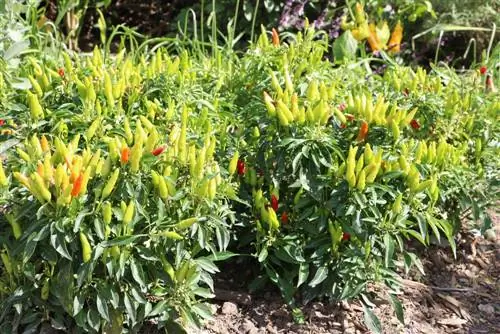
The plant is effectively propagated via the seeds that can be found in the fruits. If you don't want to buy seeds and already have an ornamental pepper, you should remove the seeds from the fruit, wash them and dry them. Make sure that there are no remaining peppers stuck to the seeds, as this could cause them to rot. Then proceed as follows:
- Germination temperature: 20°C - 28°C
- Time: from February
- Indoor greenhouse is recommended as the temperature remains constant
- Multi-pot plates are suitable for cultivation
- fill classic potting soil into the pots
- Place two to three seeds about five millimeters into the soil, then press the substrate lightly
- moisten with a spray bottle
- Lid or foil over the pots
- ventilate and moisten the substrate at regular intervals
- don't keep it too moist
- the seeds need between one and three weeks to germinate
- look at the seedlings
- If several seeds have germinated per pot, you must remove the weakest specimens
- just pull these out of the ground
- then allowed to mature into young plants
- Repot the peppers as soon as they have become too big for the container
- water adequately throughout the entire growing season
Diseases and pests
If the care instructions are followed thoroughly, the risk of diseases or pests is quite low. However, ornamental peppers can suffer from the following problems if care errors occur, especially during wintering:
- Spider mites: webs that resemble spider webs on drying leaves and shoot branches, increase air humidity, use soft soap solutions
- Aphids: shoot tips take care of themselves, then die, fight with irrigation
- Whitefly: attacks the undersides of leaves, yellow-spotted, drying leaves follow, combat with yellow plates
- Verticillium wilt: leaves turn light green, conductive pathways brown, plant must be disposed of immediately
- Gray mold rot: gray mold on leaves and stems, remove affected parts of the plant or dispose of the plant
Note:
You should take action against these problems quickly so that your sweet tooth doesn't die or infect other plants.

